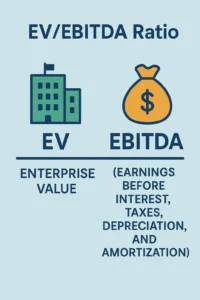EV/EBITDA Calculator
Enterprise Value to Earnings Before Interest, Taxes, Depreciation, and Amortization
This ratio is a widely used financial metric for evaluating a company’s valuation and financial health.
The EV/EBITDA ratio compares a company’s overall value to its operating income and is useful in determining its financial stability.
Users input the company’s Enterprise Value (EV) and Earnings Before Interest, Taxes, Depreciation, and Amortization (EBITDA), and the calculator swiftly calculates the EV/EBITDA ratio.
This calculation is particularly helpful in evaluating companies in the same industry, as it allows for an apples-to-apples comparison.
This ratio serves as a key indicator for investors and financial analysts to assess the company’s overall valuation and operating performance.
A higher ratio may indicate that a company is overvalued, while a lower ratio may suggest that it is undervalued.
With its quick results, the EV/EBITDA Calculator empowers users to make informed investment decisions and perform thorough financial analysis.
The EV/EBITDA Calculator is a valuable tool for any investor or analyst looking to assess a company’s financial health.
What is EV to EBITDA

Understanding the EV/EBITDA Ratio
The EV/EBITDA calculator is a powerful tool for investors and analysts to evaluate a company’s valuation. This ratio compares the Enterprise Value (EV) of a company—its market capitalization plus debt, minus cash—to its EBITDA, a measure of core profitability.
Unlike other metrics, such as the Price-to-Earnings (P/E) ratio, the EV/EBITDA ratio provides a more holistic view by considering debt and cash, making it especially useful for analyzing companies with different capital structures or tax burdens.
Why Use the EV/EBITDA Ratio?
The EV/EBITDA ratio is widely regarded as one of the most reliable indicators of valuation efficiency. It helps investors quickly assess whether a stock is overvalued or undervalued compared to its peers or industry benchmarks. This ratio is particularly valuable in capital-intensive industries like telecommunications, manufacturing, or utilities, where depreciation and amortization costs can vary significantly between companies.
How the Calculator Works
To calculate the EV/EBITDA ratio, you need two key inputs:
1. Enterprise Value (EV): This represents the total valuation of a company, including its market capitalization, debt, and minus its cash reserves. It reflects the cost to acquire the entire business.
2. EBITDA: This is a measure of the company’s operating profitability, focusing on earnings before interest, taxes, depreciation, and amortization.
The calculator divides the Enterprise Value by EBITDA to produce the EV/EBITDA ratio. A lower ratio often suggests that a company is undervalued relative to its earnings potential, while a higher ratio might indicate overvaluation.
Interpreting the Results
While the EV/EBITDA ratio provides valuable insights, it should always be considered in context. For example, companies in high-growth industries may naturally have higher ratios due to their strong future potential, while businesses in mature or slower-growing industries may have lower ratios.
Investors should also compare the ratio to industry averages or historical data for a more accurate assessment. Combining this analysis with other financial metrics, such as revenue growth or profit margins, can offer a comprehensive view of a company's value and prospects.
Practical Applications
The EV/EBITDA ratio is versatile and applicable in various scenarios. For instance, it is widely used in mergers and acquisitions to determine whether a company’s valuation aligns with its profitability. Additionally, investors often rely on it to identify undervalued stocks or to compare competitors within the same sector.
By using the EV/EBITDA calculator, you can streamline this process, ensuring accurate and efficient valuations. This tool is invaluable for anyone looking to make informed investment decisions, whether they are seasoned analysts or newcomers to the market.
FAQ: EV/EBITDA Calculator
Compare a company’s Enterprise Value with its EBITDA for a quick, capital-structure-neutral valuation check.
What does EV/EBITDA show?▾
How do I calculate it on this page?▾
- Build a clean EV with the EV Calculator.
- Enter EBITDA for the same period and scope (TTM or annual).
- We compute:
EV/EBITDA = Enterprise Value ÷ EBITDA.
Which EBITDA should I use?▾
- TTM or latest annual EBITDA, adjusted for clear one-offs.
- Keep accounting basis consistent (IFRS/US GAAP) and match consolidation scope to EV.
- If you compare forward EV/EBITDA, use forward EBITDA consistently across peers.
How do I handle leases and minorities?▾
- Include leases in EV (lease liabilities) and use reported post-IFRS 16 EBITDA (no rent add-back); or
- Exclude leases from EV and compare using pre-IFRS/EBITDAR for all peers.
How should I interpret the result?▾
- Compare to sector peers and the firm’s history.
- Consider growth, margin quality and capital intensity—EV/EBITDA ignores CapEx.
- Use alongside EV/EBIT and a DCF for a fuller picture.
When is EV/EBITDA less useful?▾
Common mistakes to avoid▾
- Mixing book debt with market equity dates in EV.
- Using EBITDA with one-offs or different scope than EV.
- Inconsistent lease treatment across companies or time.
- Comparing equity multiples (P/E) directly with EV-based ones.
Quick workflow on this page▾
- Compute EV in the EV Calculator.
- Enter normalized EBITDA (TTM or annual) and review the multiple.
- Benchmark on Stock Valuation; if attractive, model with a DCF.
Is this investment advice?▾
Unleash Your Stock Data Instantly.
100% Satisfaction - 0% Risk - Cancel Anytime.
